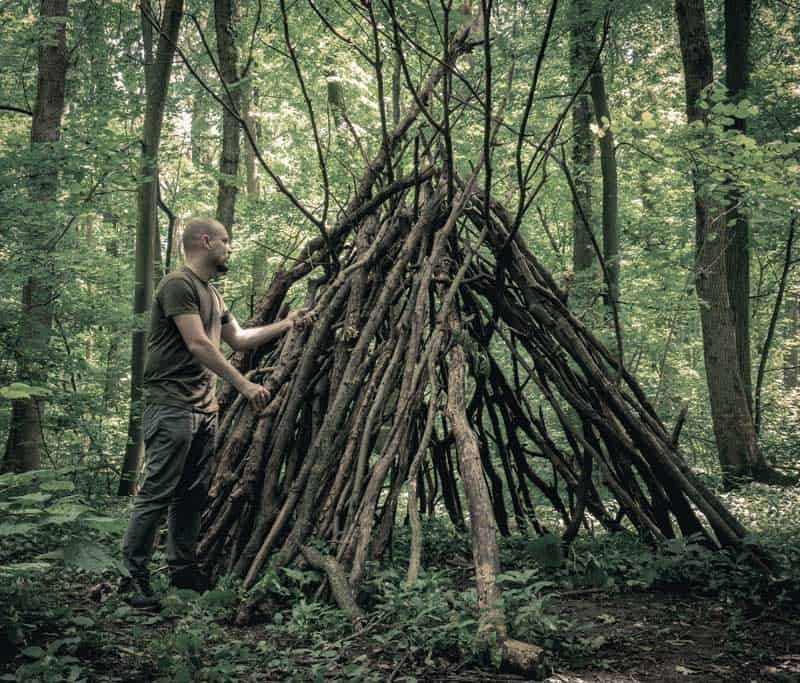Building a Wilderness Survival Shelter: Essential Tips for Staying Warm and Dry
Are you an outdoor enthusiast looking to explore the backcountry? Having the knowledge to build a wilderness survival shelter is an invaluable skill. Whether you’re an experienced camper or just starting out, having the ability to make an effective shelter can be the difference between staying warm and dry or facing the elements in the cold and rain.
In this article, we’ll explore essential tips for building a wilderness survival shelter that will ensure you stay safe and protected during your next wilderness adventure. We’ll go over the important elements of a shelter, the best building materials, and provide detailed instructions for putting it all together. So, let’s get started on building your wilderness survival shelter!

Selecting a Site
Selecting the right site for your wilderness survival shelter is one of the most important steps. You’ll want to look for an area that is sheltered from the wind and rain, yet still provides good air circulation. Additionally, look for a dry area that will not flood or become muddy during a rainstorm. When possible, try to find an area that is away from any potential hazardous areas or wild animals.
When scouting for the perfect shelter site, consider the natural resources in the area. Are there trees or rocks that can be used for building materials? Are there plants that can be used for firewood or protection? Do you have access to fresh water nearby?
It’s also important to consider the potential dangers of the area, such as falling trees, wild animals, and nearby waterways. Knowing these elements will help you choose the best site for your survival shelter.
Choosing the Right Building Material
When constructing a wilderness survival shelter, the choice of building material is an important factor to consider. The material should not only provide a sturdy structure but also be lightweight and easy to transport. Depending on the terrain and climate you’re dealing with, some common building materials include tarp, canvas, sticks, branches, and leaves.
Tarp is a great option for building a shelter, as it’s lightweight, waterproof, and very versatile. It also creates a good barrier between you and the ground and can be set up in a variety of ways. You can hang it from trees, use it as a floor, or even wrap it around a frame for additional stability.
Canvas is another excellent choice, as it’s durable, waterproof, and easy to carry around. This material is great for wrapping around a frame and can provide added protection from the elements.
Sticks and branches can also be used to create a basic frame, but they should be used in combination with another material to provide a sturdy shelter. Leaves can also be used to cover the shelter, creating an effective thermal barrier.
When choosing the right building material for your wilderness survival shelter, be sure to consider the climate you’re in, the type of terrain you’re dealing with, and the weight of the material you plan on using.
With a few of these essential tips, you can craft a shelter that will give you peace of mind during your next wilderness adventure.
Constructing the Frame
Constructing a wilderness survival shelter is an invaluable skill for outdoor enthusiasts. When building a shelter, there are several key elements that must be considered. Firstly, the structure of the shelter should be solid and sturdy, made from materials such as logs, rocks, or branches that are available in the area. Secondly, the shelter should have enough coverage to protect the user from rain and wind. Additionally, the shelter should be insulated to keep the user warm and dry.
When constructing the frame of the shelter, it is important to consider the environment and the materials that are available to build with. Depending on the location and climate, the frame should be built out of strong, durable materials such as logs, rocks, or branches of trees.
If logs are used, ensure that they are densely packed together to ensure stability and coverage. Additionally, the frame should be constructed with an angle in mind to ensure that rain will run off the shelter and to help keep the user warm and dry.
Lastly, it is important to place additional material such as leaves, moss, or pine needles on the shelter to help insulate it and provide additional protection from the elements.
Adding Insulation
Adding insulation to your wilderness survival shelter is an important step in ensuring your safety and comfort. By adding insulation, you can trap in your body heat so that you don’t become too cold in the night.
There are a variety of options for insulating your shelter, ranging from natural materials such as moss and leaves, to man-made materials such as a tarp or blankets. Additionally, you can use waterproof plastic sheets to line the inside of your shelter, which will help to keep the moisture out and your shelter warm.
When adding insulation, make sure it is thick enough to create a layer of air between you and the outside of the shelter. It’s also important to make sure that the insulation is well-packed around the frame of the shelter and that there are no gaps or holes where heat can escape.
You may also want to bring along some chemical hand warmers to help keep your shelter warm during the night. With the right materials and attention to detail, you can easily create a cozy and warm refuge for yourself in the wilderness.
Finishing Touches
Finishing touches are the key to any wilderness survival shelter. The best shelter is one that looks as if it were meant to be there and not just cobbled together from whatever materials were available. Adding a few extra touches to your shelter can create a comfortable and inviting retreat from the elements.
The first way to add a finishing touch to your shelter is to use a variety of materials. A combination of natural items such as sticks, stones, and leaves can all be used to create a more aesthetically pleasing result. Incorporating different colors and textures can also give your shelter a more natural feel.
The second way to add finishing touches to your shelter is to use cordage and other fastening materials to create dividers, shelves, or walls in your shelter. This can be used to store or hang items, or to divide the shelter into different areas.
Using cordage to fasten materials together also helps to make the shelter more secure in high winds. Adding a few decorative touches such as feathers, fur, or beads can also give the shelter a unique look.
By adding a few finishing touches to your shelter, you can create a safe and comfortable retreat from the elements that is sure to impress. With a little bit of creativity and the right materials at hand, you can transform a simple shelter into an inviting home away from home.







